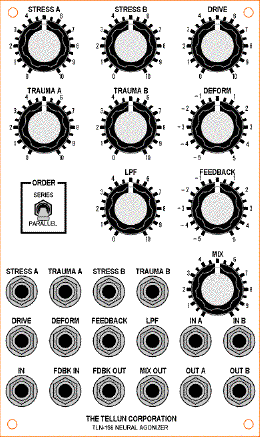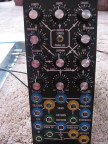
Back to Synth DIY Projects
Last updated: March 14, 2017
DescriptionThe TLN-156 Neural Agonizer is a voltage controlled spring reverb processor. Although this module can be used to simulate room reverb with most audio signals, it includes numerous enhancements specifically designed for interfacing to a modular synthesizer. If you're looking for a smooth, natural sounding reverb system to make your synthesizer sound like its being played in the Concertgebouw, then go buy a Lexicon. This is not your grandmother's reverb tank, this is a noxious tool capable of inflicting some serious damage to your audio. The TLN-156 features: an amplifier for controlling the input signal level, two reverb tanks that can be driven in series or parallel, separate recovery amplifiers and resonators for each reverb tank, a feedback amplifier with lowpass filter, and a deformation processor for combining the reverb tank outputs. Most parameters are voltage controllable and several patch points are available for adding additional signal processing. All inputs and outputs handle 10 Vpp audio signals and 5 volt control voltage signals (modular standard). Total current draw for TLN-156 is 70 mA @+15V and 70 mA @-15V. |
||||||
Availability: Sold OutMOTM-style front panels for this module can be ordered from The Bridechamber and Stooge Panels. |
||||||
DownloadsThe User Guide does not contain detailed explanations on how to install parts or which kinds of solder to use. The intended audience is the experienced kit builder who is quite comfortable building a circuit from a description, a parts list, and a schematic. Calibration routines are included. View the TLN-156 User Guide rev 1.1.1 (pdf) Graze over the TLN-156 Schematics rev 1.1 (pdf) Handy panel wiring diagram courtesy of Tom Farrand (pdf) The Accutronics Reverb website has lots of information about their reverb tanks (specifications, mounting details, where to buy, and more). The TLN-156 User Guide contains specific information about selecting suitable Accutronics reverb tanks for the TLN-156. |
||||||
Pictures & Links
Hints for mounting reverb tanks Ryan's TLN-156 with Steve Thomas panel TLN-156 construction by Tom Farrand |
||||||
Sound SamplesThese demos feature the TLN-156 in some simple patches that were recorded without any added effects.
|


